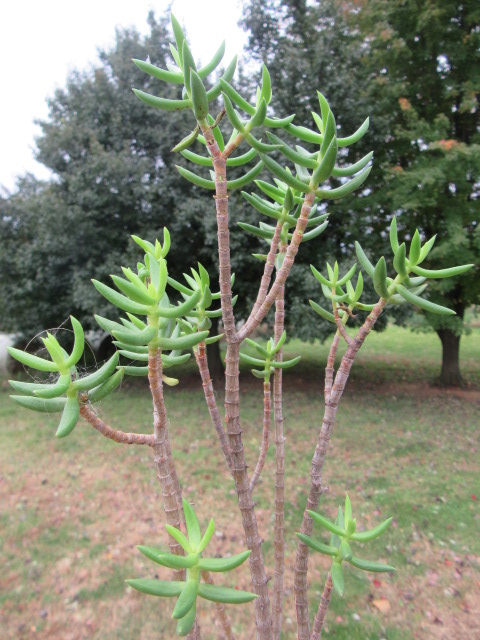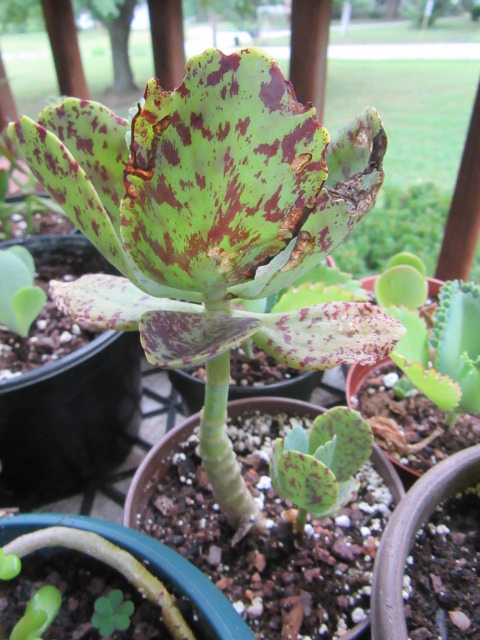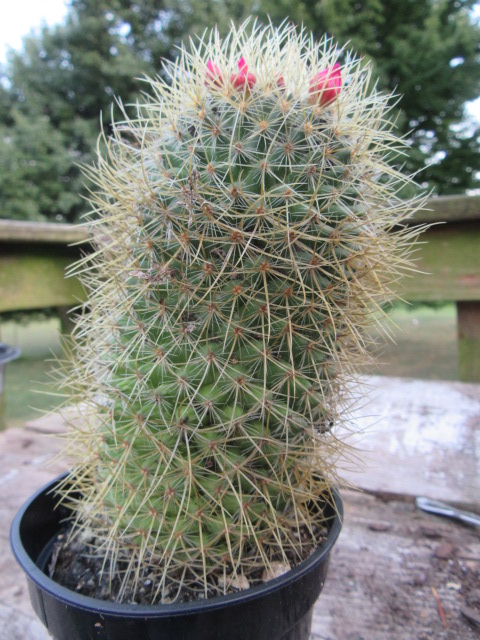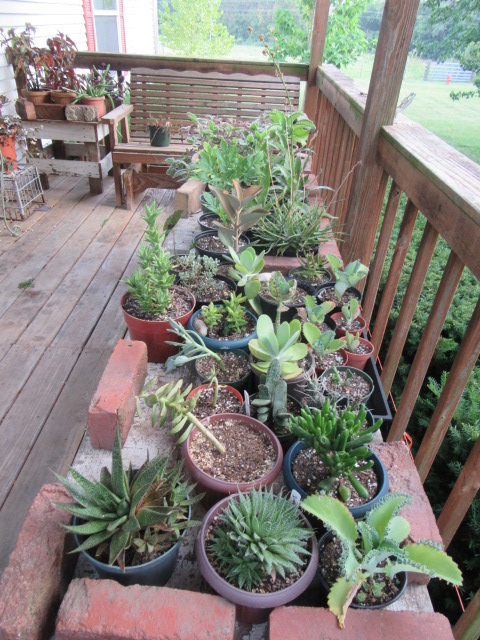
Plants mentioned in Cactus and Succulent Update Part 2 on 10-26-19, #645-1. On the railing, from left to right, Cereus forbesii f. monstrose ‘Ming Thing’, Cereus repandus f. monstruosus ‘Rojo’, and Cereus hildmannianus subsp. uruguayanus. The large pot in the center is Echinopsis huascha (var. grandiflora ?). Plants to the left of the big pot are Cotyledon orbiculata ‘Silver Storm'(rear) and Echinopsis ‘Rainbow Bursts’. To the right of the big pot are Crassula tetragona (rear) and Crassula ovata ‘Gollum’. In front are the twin Echinocactus grusonii (var. albispinus ?), Echinopsis mirabilis (small pot), and Echinopsis huascha (var. grandiflora ?) on the right.
Hello everyone! I hope this post finds you well. This is part 2 of the cactus and succulent update. After the light “F” we had during the night on October 11, it warmed up again. The plants were giving me crazy looks and probably talking behind my back. I know this because they would get very quiet when I walked in the room and start looking at each other. They had that guilty look… Then sometimes they would be staring out the window with a bit of drool funning down their chin, or a tear in their eyes. ENOUGH WAS ENOUGH, so I put them back outside for a few days. This time, the temps were chilly, it was cloudy and the wind blew every day. I was going to make sure they were ready to come inside and knew “W” was on the way. Even though another “F” wasn’t isn’t in the forecast for a few days, the temperature was going to get below 40 on Thursday night (by morning), so I brought them back inside. This time, they were ready and thankful.
I am continually updating, so if you click on their pages they may or may not be updated with these current photos.
Here we go…

Cereus forbesii f. monstrose ‘Ming Thing’ at 2 1/4″ tall x 3 1/2″wide on 10-11-19, #639-13.
The last Cereus forbesii f. monstrose ‘Ming Thing‘ I bought from Wal-Mart in February 2016 is definitely taking its time growing. I suppose that is petty normal when it started out so small in the first place. It has only grown 1/4″ taller since I brought it home and is now at 2 1/4″. The width is the same at 3 1/2″. It is scarred for life from the crickets in 2016… It has no good side… Maybe the crickets stunted its growth. My complete history with Cereus forbesii f. monstrose ‘Ming Thing’ from 2009 to present can be seen by clicking HERE.

Cereus hildmannianus subsp. uruguayanus (Fairy Castles) at 6 1/2″ tall x 4 1/2″ wide on 6-11-19, #639-14.
The Cereus hildmannianus subsp. uruguayanus (Fairy Castles) is one of very few cactus companions I have whose name has not changed or isn’t controversial. I write that while laughing because there are 27 synonyms associated with this species. At least it hasn’t changed since I brought it home from Wal-Mart in January 2016. This subspecies is also an accepted name because it pretty much only grows in Uruguay (Syn. Cereus uruguayanus). Growing this plant has definitely been an interesting experience from the start. It looked pretty good when I brought it home but it was sopping wet. Then it was nibbled on by crickets in 2016. It turned pale instead of remaining nice and green and I thought it would die. Well, it didn’t die and many of the offsets are almost as tall as the original main stem. Any new offsets don’t seem to be coming from around the plant but within it. Damaged stems produce new growth that sometimes falls off. Since it seemed to sunburn even in light shade, I tried growing it in more shade to see if the color would get better. Well, that didn’t help. So, this year I kept it in full sun on the back porch. Nothing changed one way or the other. It still looks rather odd to me and it is definitely not a showstopper (unless you are a cricket). On the back porch, which is actually a deck 4′ above the ground, there are no cricket issues… I always measure the cactus from soil level to the top of the plant. This one shrunk because the top of the oldest and tallest trunk was damaged and the new growth fell off. Last October it was 7 1/4″ tall and now it is 6 1/2″ tall. It is still the same width as last year at 4 1/2″.
You can view this plant’s own page by clicking HERE…

Cereus repandus f. monstruosus ‘Rojo’ at 8″ tall x 3 3/4″ wide on 10-11-19, #639-15.
The Cereus repandus f. monstruosus ‘Rojo’ hasn’t been fooling around! It was 5 1/2″ tall x 3 3/8″ wide when I brought it home from Wal-Mart in March 2018. It had grown to 6 7/8″ tall x 3 3/4″ wide by the time I brought the plants inside in October. Now it measures 8″ tall but it is still 3 3/4″ wide. I bought my first Cereus repandus f. monstruosus ‘Ming Thing’ in 2010 when I lived in Mississippi and it didn’t look anything like this one. As with all monstrose forms in any species, no two are alike.

Cereus repandus f. monstruosus ‘Rojo’ from the top on 10-11-19, #639-16.
I really like this plant’s growth habit and reddish-brown spines. It is interesting anywhere you look at it.
If you have or encounter a cactus that says Cereus peruvianus f. monstrose ‘Rojo’, it is the same. Cereus peruvianus has been a synonym of Cereus repandus for quite a while but the industry is still using the same old name. The infraspecific name is not an accepted scientific name. Monstruosus forms appear in nature as well as cultivation.
To view this plant’s own page, click HERE…

Cotyledon orbiculata ‘Silver Storm’ on 10-26-19, #645-2.
“I saw her before with her silvery glow, tempting me to bring her home. Not just for the evening, but for much longer, maybe a lifetime. Maybe not mine. For I knew parasites may soon come and take her away… So, I hesitated, then went home without her. She haunted me from far away until I returned and gave in. Now she is here with me, her flesh now loaded with brown scale.”
Ummm… While most of the plants are doing well, the Cotyledon orbiculata ‘Silver Storm’ (Pig’s Ear, etc.) is not. For those of you who may have a Cotyledon orbiculata ‘Silver Storm’ that is healthy and growing well, I congratulate you! When I first saw several of these at Wagler’s Greenhouse in 2017, they were AWESOME. Every year they have a few and they have big, beautiful, silver leaves are so amazing. However, although I haven’t asked, I think they purchase them every year. Commercial growers sell to retailers that are unaware of what lurks yet to be seen. The problem is, local greenhouses have a clientele that come often and soon learn to avoid certain plants. After a few years, they can’t sell certain plants unless they sell them to new customers. This plant, in particular, can lead to frustration because of what happens next. Being very prone to brown scale, and likely invisible when buying, they soon develop these brown spots and the plant starts ailing.

Cotyledon orbiculata ‘Silver Storm’ with a big problem…
I have had only a few plants that have had issues with brown scale. One was the HUGE Crassula ovata (Jade Plant) that always has a few brown scale that I could easily remove with my fingernail. They never became an issue. Then there was the Crassula arborescens ssp. undulatifolia (Ripple Jade Plant) that I brought home from Pleasant Acres Nursery while living in Leland, Mississippi. It looked great when I brought it home, but soon the brown scale started appearing in greater numbers I could remove with my fingernail. I treated the plant with Garden Safe Fungicide 3 (fungicide, insecticide, miticide) which is OMRI listed. I went to the nursery and the plants she had were completely infested as well and MUCH WORSE than mine. The spray helped a lot but the plant was never the same. I brought the plant with me when I moved back here and after a while I ran out of spray. I went to the local hardware store and found a similar product but it wasn’t OMRI listed and smelled of alcohol. It killed the plant within a few days.
To me, I don’t even think the Cotyledon has brown scale. It is something else. I posted the photos on the group Succulent Infatuation on Facebook to see if I can get some answers. I hate to discard this plant because it wants to survive. Last fall I was tempted to leave it outside, but my conscious wouldn’t allow it. Last August I have it a good trim and took several cuttings. Once it regrew the same issues came back as well. I was busy over the summer and somehow I don’t remember what happened with the cuttings.
I hadn’t taken photos of this plant for A LONG TIME because I was wither embarrassed or ashamed. Not sure which… So much for my “green thumb” status. LOL!
To view the Cotyledon orbiculata ‘Silver Storm’ page click HERE. You can see what it looked like when I first brought it home.

Crassula ovata ‘Gollum’ at 7 1/2″ tall x 9 1/4″ wide on 10-11-19, #639-20.
I brought this Crassula ovata ‘Gollum’ (Jade Plant ‘Gollum’) home from the Kuntry Bulk Grocery (one of the local Amish stores) last May. It was unlabeled and I originally thought it was a Crassula ovata ‘Ladyfingers’ like the one I had previously. The more it grew the more “Gollamy” it appeared. I like rolled-up leaves and tree-like growth habit. Somehow I didn’t measure this plant when I brought it home, but it is currently 7 1/2″ tall x 9 1/4″ wide.
Click HERE to view the page for the Crassula ovata ‘Ladyfingers’. Hmmm… I put the photos of the current plant on this page because I thought it was ‘Ladyfingers’ at first. I suppose I either need to change the name of the title or add a separate page for this plant.

Crassula tetragona (Miniature Pine Tree) at 16 1/2″ tall on 10-28-19, #645-4..
Hmmm… I forgot to take photos of this plant on October 11 and didn’t realize it until I went to write about it. There were no photos! The Crassula tetragona, Miniature Pine Tree, has changed quite a lot since I brought it home from Wagler’s Greenhouse last September. For one, it has grown from 11 1/4″ tall to 16 1/2″ tall. It lost A LOT of leaves while it was inside last winter making me wonder if it needs a little more water than other Crassula species over the winter. In their native South African habitat, this species grows in both areas with summer rainfall and areas with winter rainfall. I put the Crassula tetragona on the back porch for the summer with the cactus and it did very well. It was first on the north side of the porch, but as the cats jumped from the raining to the table they kept knocking off the tops of the stems. So, I moved it to the potting table on the south side of the porch.

Crassula tetragona (Miniature Pine Tree) on 10-26-19, #645-5.
Even though the leaves are now concentrated to the top of the plant, I think it looks pretty neat.

Crassula tetragona (Miniature Pine Tree) on 10-26-19, #645-5.
Every time I found a broken stem I put them in the pot. Soon there will be a forest in the pot.
According to information online, the Crassula tetragona is reliably cold hardy down to 28° F or even colder for short periods. They are also popular as bonsai candidates.
Click HERE to view the page for the Crassula tetragona page.

Echinocactus grusonii (var. albispinus ?) on 10-11-19, #639-21.
The twin Echinocactus grusonii (var. albispinus ?), commonly known as the Golden Barrel Cactus, are both doing quite well. As always, they are the comedians of my cactus companions. I had named them Greater and Lesser because one is a little taller and narrower than the other. Greater is taller and narrower while Lessor is a little shorter but wider. They always try to confuse me when I am measuring them. Occasionally, Lessor will stand on its toes and Greater will puff out its stomach. Their long thorns don’t make it any easier. Since last October, Greater has grown from 2 7/8″ tall x 2 1/2″ wide to 3″ tall x 2 3/4″ wide. It was 2 1/2″ tall x 2″ wide when I brought it home from Wal-Mart in February 2016. Lessor has grown from 2 1/2″ tall x 2 3/4″ wide last October to 2 7/8″ tall x 3″ wide. It was 2 1/8″ tall x 2 1/4″ wide when I brought it home the same day as Greater. Those measurements are without the spines…
To view Greater and Lesser’s own page click HERE.

Echinopsis ‘Rainbow Bursts’ at 3 3/8″ tall x 6″ wide on 10-11-19, #639-22.
The Echinopsis ‘Rainbow Bursts’ (Syn. x Echinobivia ‘Rainbow Bursts’) has grown A LOT this past summer and so have its kids! The parent is now 3 3/8 ” tall and the whole cluster is 6″ wide. That is 3/8″ taller and 1″ wider than last October. The real change has been the size size of the offsets which you don’t notice by measuring the whole cluster. It was only 2 1/4” T x 3 1/2” W when I brought it home from Wal-Mart in February 2016.
Echinopsis ‘Rainbow Bursts’ was an intergeneric hybrid between Echinopsis and Lobivia species (or cultivars). That was until Lobivia became a synonym of Echinopsis. Actually, species of Lobivia were moved to several different genera. They are known for their AWESOME flowers and I am STILL waiting…
Click HERE to view the Echinopsis ‘Rainbow Bursts’ page.

Echinopsis huascha (var. grandiflora) at 3 1/2” tall x 2 1/2” wide on 10-11-19, #639-23.
ALL of the Echinopsis huascha (var. grandiflora) are doing very well. Common names include Red Torch Cactus and Desert’s Blooming Jewel. Hard to imagine, but this plant, according to Plants of the World Online, has 42 synonyms and has been in 8 different genera!

Echinopsis huascha (var. grandiflora) on 10-11-19, #639-24.
Ummm… How did I wind up with this many Echinopsis huascha (var. grandiflora)? Well, I wrote about this before, but I will do it again. I was at Lowe’s looking at cactus on September 12 last year and noticed several cactus on a rack I didn’t have. One of those plants was the one pictured above the above photo. When I was walking around the garden center, I spotted a bigger pot with a very large dead cactus in the middle surrounded by 6 offsets. The pot was on clearance for $5.00 and I figured I could repot them. SO, I put the pot in the cart. When I got home I started taking photos, writing the names down and measuring the new companions. Hmmm… I brought home several plants that day… Anyway, I kind of slipped (AGAIN) and wound up with two pots labeled Trichocereus grandiflorus Hybrids. As it turns out, Trichocereus grandiflorus is a synonym of Echinopsis huascha which looks more like photos of the variety Echinopsis huascha var. grandiflora. Well, the later infraspecific is neither approved or listed as a synonym… Anyway, that’s how I came up with seven of these plants. 🙂 I am waiting for their AWESOME flowers!
When I brought home these plants, the one in the pot by itself measured 3″ tall x 2″ wide. It now measures 3 1/2″ tall x 2 1/2″ wide. The largest plant in the center of the pot of six now measures 4 3/4” tall x 3 1/8” wide. It was 3″ tall x 2 3/4″ wide when I brought them home.
Click HERE to view the Echinopsis huascha var. grandiflora page.
LAST ON THE POST
BUT CERTAINLY NOT THE LEAST!

Echinopsis mirabilis (Flower of Prayer) at 3 1/2″ tall on 10-11-19, #639-25.
I have and have had some of the neatest plant companions and will certainly have more to come. I have identified more wildflowers this past summer and some have been really neat. I may never see another pink-flowered Achillea millefolium in nature like I did this past summer. Even so, I would have to say the highlight of this past summer was when the Echinopsis mirabilis started flowering.
Watching and waiting for the bud to open when the flowers only last one night is is quite an ordeal. Especially when I missed the first one. I saw the second and then missed the third. Then the fourth was the day after the third which I did photograph as well. The flowers are AWESOME and worth the anticipation. Like my cousins Cereus, they are night bloomers…
Even though it looks like the plant hasn’t grown to me, it has. When I brought it home, it measured 2 5/8″ tall x 1 1/8″ wide. It now measures 3 1/2″ tall. It needs a new pot…
To view this plant’s own page with the flowers, click HERE!
Now I am finished with part 2. Part 3 and 4, maybe 5 or 6, are coming up. 🙂
I hope you enjoyed this update as much as I enjoy sharing it. Until next time, be safe and stay positive. Make a comment or click like if you can because I really enjoy hearing from you.
































